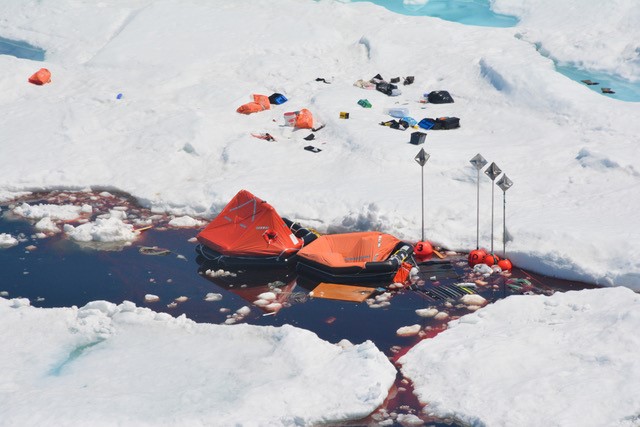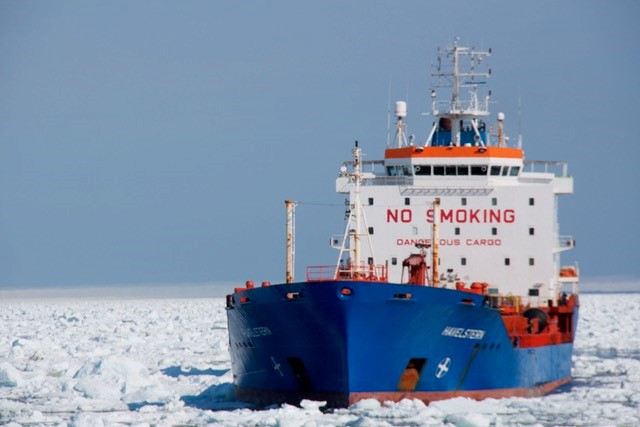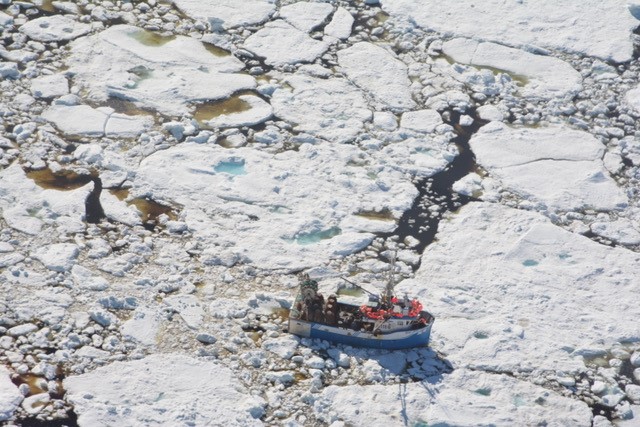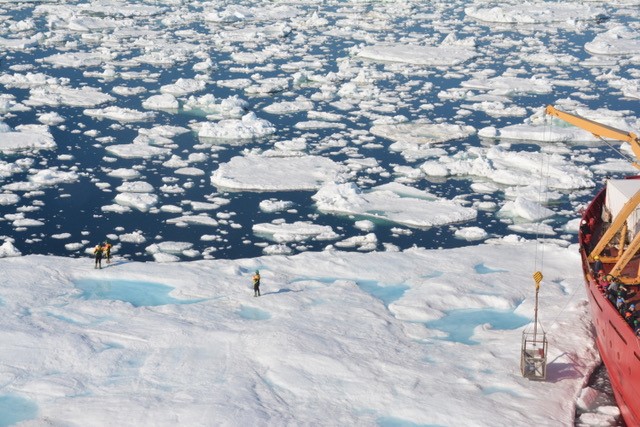E17 – Science Turns to Search and Rescue
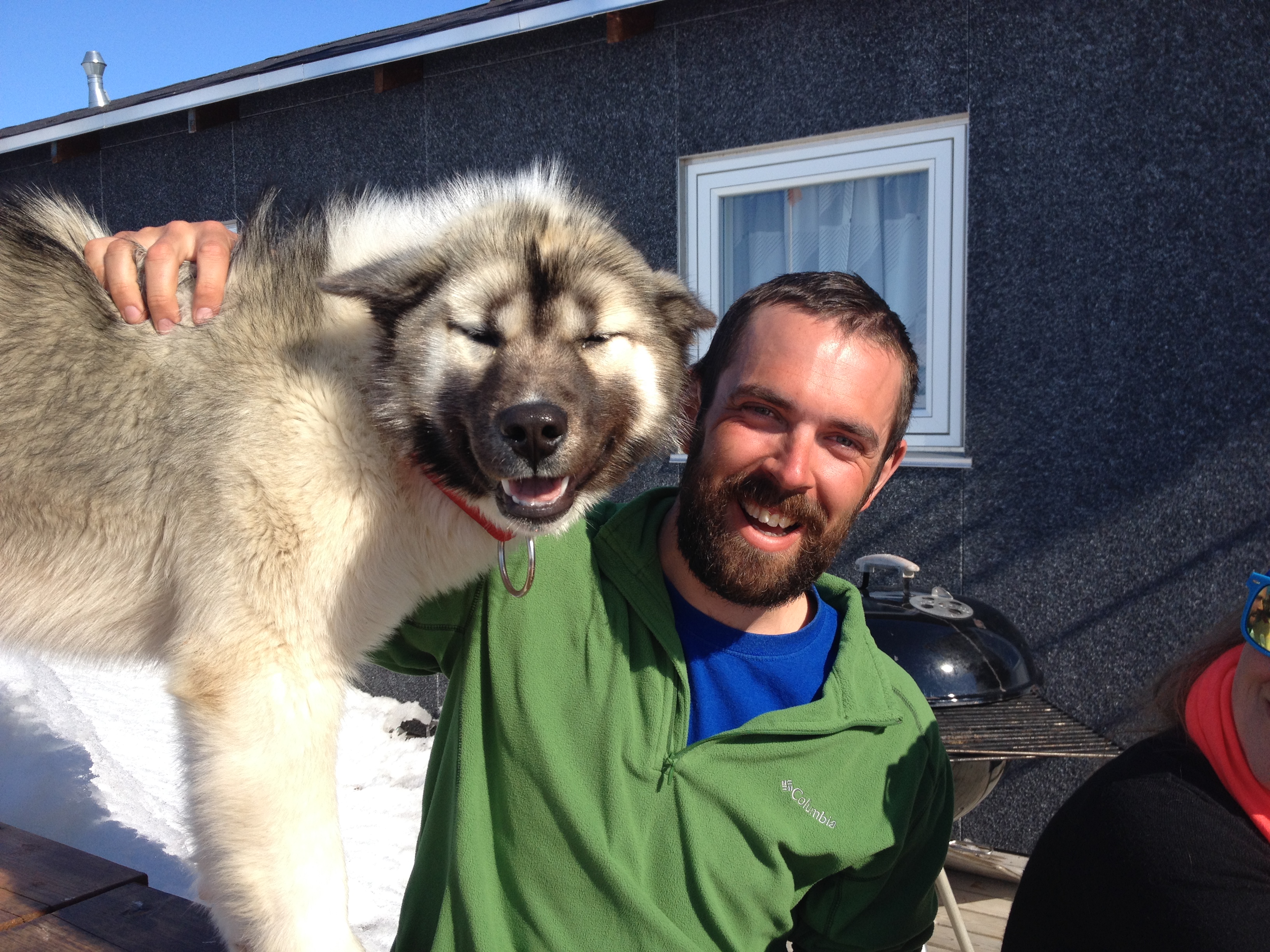
David Babb with his dog Molly. Credit: David Babb.
The Arctic Ocean is topped with a layer of frozen sea water – sea ice – that grows every winter and shrinks every summer. To study the ice in detail, researchers hop aboard an icebreaker ship that can plow through the sharp, cold ice floes without being damaged.
But two years ago, the Canadian icebreaker Amundsen was called off its scientific mission to assist the Canadian coast guard with search and rescue operations in the North Atlantic Ocean. In May and June of 2017, an unprecedented amount of sea ice was choking the normally open waters around Newfoundland. The thick ice trapped many unsuspecting ships and sunk some boats when the ice punctured their hulls.
In this episode, University of Manitoba sea ice expert David Babb recounts the 2017 rescue operations the Amundsen took part in. David discusses what it’s like to live and work on an icebreaker and describes the unusual conditions that allowed a record amount of Arctic sea ice to flow south and wreak havoc on ships in the North Atlantic that year.
This episode was produced by Lauren Lipuma and mixed by Kayla Surrey.
Episode Transcript
Nanci Bompey: So I hear that you were rescued?
Shane Hanlon: We’re just getting right into it. Hi Nanci!
Nanci Bompey: I mean not that you’re like a rescue dog. You were telling us that one time you actually were in a situation where you had to be rescued.
Shane Hanlon: Okay, yes. When I was like 11, I went white water rafting with my … I have a bunch of older brothers and father and they used to do this all the time, and it was the first time they ever took me. This whole time I was with my dad and my godfather in a boat, in a raft, with the guide. So we were like the safe boat, all my brothers and all their friends were in other rafts. We’d get to the very end of this entire course, this entire day, and my brothers convinced my dad to put me in the boat with them. So we’ve been great, no one’s flipped, nothing like that. We’re going around a rock, we’re going under rapids, and we end up hitting a rock and flipping immediately. This is a rock where people die. Every year, people get sucked under this thing. So, we flip and I’m going down the river, and I’m freaking out and thrashing, and I see one of my friends – my brothers friends – I yell out “Brian! Save me!”
Nanci Bompey: They must not let you live that one down.
Shane Hanlon: To this day, he pulled me off this rock and everyone’s like, literally to this day, I see him every once in a while in my home town when I go home. This is 20 years ago at this point. He’ll say like, “Hey Shane, remember that time I saved you?” I’m like, “Thanks Brian, that’s really great.”
Shane Hanlon: Welcome to the American Geophysical Union’s podcast about the scientist, and the methods behind the science. These are the stories you won’t read in the manuscript, or hear in a lecture. I’m Shane Hanlon.
Nanci Bompey: And I’m Nanci Bompey.
Shane Hanlon: And this is Third Pod from the Sun.
Nanci Bompey: So you have your own personal hero?
Shane Hanlon: I do, yeah.
Nanci Bompey: That’s lovely.
Shane Hanlon: I can’t really let him know about it, I gotta be tougher than that.
Nanci Bompey: You be cool. Yeah man! Thanks! Is that how you say it?
Shane Hanlon: That is exactly how I speak. Yeah, yeah dude, yeah thanks-
Nanci Bompey: Thanks bro.
Shane Hanlon: … no big deal. All right, anyways. So, talking about rescues. We’re talking about this because we actually have a story today about an unexpected rescue with a bit of a science twist. So, Lauren, can you tell us where we’re going with this?
Lauren Lipuma: Yes. So last year, I interviewed a scientist who studies Arctic sea ice.
David Babb: I’m David Babb. I’m a research associate and PhD student at the University of Manitoba, in Canada. I study sea ice dynamics and thermodynamics.
Lauren Lipuma: David told me this story about how he and his colleagues were involved in a search and rescue mission, in the Arctic ocean a few years ago.
Shane Hanlon: They didn’t set out to do that, right? They’re scientists.
Lauren Lipuma: Right, no. It was totally unexpected, but as it happens they do a lot of work on this ship that’s an icebreaker in the Canadian Arctic. So, actually before we get into the rescue mission, it’s kind of interesting to hear a little bit about what it’s like to live and work on this ship.
David Babb: We spend a lot of time in the Canadian Arctic, both in research camps and on the Amundsen, the Canadian icebreaker that does science research.
Lauren Lipuma: Mm-hmm (affirmative).
David Babb: I love working on the icebreaker, it’s great. It’s a good group of people. It’s 80 people, and when you’re on the icebreaker it’s very, very comfortable. There’s chefs from Quebec who make excellent food when we’re on the ship. There’s satellite T.V.-
Lauren Lipuma: … Oh wow.
David Babb: You have a very comfortable room with your roommates. There’s a gym on board.
Lauren Lipuma: Really?
David Babb: It’s all very luxurious, it’s very comfortable. It’s hard work when you’re out on the ice, and out in a skippy boat or out in the zodiac all day.
Lauren Lipuma: Mm-hmm (affirmative)-
David Babb: Once you’re on the ship it’s very luxurious. I kind of like more of the roughing it, in some of the other remote field locations. One of my favorite field campaigns has been we worked in Northeast Greenland one year, the ice had just started to form, and we were working with air boats. These big fan boats that work in the Everglades. Just like an aluminum boat with a big fan behind it-
Lauren Lipuma: Okay.
David Babb: … you can kind of cruise through open water, or over smooth, thin sea ice. We were walking on thin sea ice all the time, and setting up this equipment.
Lauren Lipuma: You were walking on it?
David Babb: Yeah.
Lauren Lipuma: What is that like?
David Babb: It was pretty wild. The first day out, we stopped the boat and it slid for a while over the thin, smooth ice. The guy I was with hopped out of the boat and started walking around on the ice, and I thought he was completely insane. I looked at him, I was like I’m not standing on that ice, there’s no way. But he was a big guy and I figured if it could hold him, it could hold me. I was gonna be okay.
David Babb: One of the things I always think about when I’m in the Arctic and out on the ice is when you’re in one of the most remote areas of the world, right, like I always think sometimes walking on sea ice is like going to the Moon because there’s a chance no one has ever walked on this piece of ice ever before, like you’re kind of setting the first footprints.
Lauren Lipuma: When did you start first going out on the icebreaker, studying sea ice?
David Babb: In the middle of February 2003, I got to go up to the Canadian Arctic and the Amundsen was actually frozen into the ice cover for that winter.
Lauren Lipuma: What happens to the ship when it’s frozen in the sea ice? I’m assuming at that point, it’s self-sufficient for as long as it’s there, right?
David Babb: Yeah.
Lauren Lipuma: Do they bring in supplies?
David Babb: So, this ship has over-wintered now in the Canadian Arctic twice. Yeah, basically it’s self-sufficient for a year. They had a barge tucked away with extra fuel so they refueled in Spring, but when the planes flew in they brought fruits and vegetables and resupplied things like that. But, basically the ship has to be totally self-sufficient for a year. There’s no Radio Shack or Home Depot to whip off to to buy replacement parts, or 2×4’s if you need to build a new shack or something like that. You have to have everything with you. Sometimes when I lay out my bag before I pack, my wife always looks at … I’ve got everything laid out and she looks and she’s like do you really need that many gloves, come on? I’m like, look, if we’re out all day the gloves get wet. They freeze, you need new gloves. At the end of the day you need fresh gloves to get back, you need waterproof gloves. If you’re working with electronics you need small gloves that you can make quick moves with your fingers.
Lauren Lipuma: Mm-hmm (affirmative)
David Babb: So I always have tons of gloves.
Shane Hanlon: Okay, so David always brings a ton of gloves when he travels. What’s the one thing you can’t live without when you travel?
Lauren Lipuma: Chapstick.
Shane Hanlon: Chapstick?
Lauren Lipuma: And hair ties.
Nanci Bompey: Ooh.
Shane Hanlon: That’s a good one.
Nanci Bompey: Mine goes back to a previous episode.
Shane Hanlon: Oh yeah?
Lauren Lipuma: Books?
Nanci Bompey: My glasses. Oh, yes! Actually, books is a really good one! As an avid reader, it causes me great stress to make sure I have enough books. I even had to get a Kindle so I can make sure I have a full stocked library when I travel.
Lauren Lipuma: That is very intense.
Shane Hanlon: Very important.
Nanci Bompey: What about you?
Lauren Lipuma: Hair gel?
Shane Hanlon: No, actually, Well, yes, actually. I’ve had to go to a convenience store or something to get hair gel if I’ve not gotten it. I have a very specific type that I get, that you can only order online. It’s very sad. Anyways, yeah.
Nanci Bompey: Wow.
Shane Hanlon: This is the world in which we live. What we pack aside, I’m still really fascinated to hear more about what it’s like to work on an icebreaker.
Lauren Lipuma: When you’re out on the icebreaker, what kind of things are you measuring and how are you measuring them?
David Babb: As a whole, the Arctic ice cover is declining in extent, but within the ice cover there’s also significant changes that are taking place. The ice cover is becoming younger, and thinner, and as a result of that the ice cover is becoming more mobile. It’s changing its physical properties and the way that its own internal feedback systems are changing as the ice cover is declining.
David Babb: We focus a lot on changes in the seasonality of the ice, changes in the thickness, changes in the composition of the ice, and then how that affects the biology, and chemistry, and physics of the Arctic system.
David Babb: A lot of the work is taking physical ice cores and drilling holes through the ice, doing snow pits and sectioning up ice cores to melt them out and look at the structure, and look at the constituents of the ice cores.
Lauren Lipuma: The ice, its physical properties can be different depending on how old it is right?
David Babb: Yes.
Lauren Lipuma: So tell me a little bit about that.
David Babb: So, when you take open sea water and freeze it, it starts to solidify, and you start to build an ice cover. That ice over winter grows to about one and a half to two meters thick. That’s called just pure thermodynamic sea ice growth. That’s temperature driven sea ice growth. During the following Spring, the ice cover starts to melt. Most of that first-year ice melts out, but some of it is able to persist through summer and remain intact into the Fall when the ice cover starts to form and freeze up again. Once the ice flow has survived through one summer, it becomes what’s known as multiyear sea ice. As the ice gets older, and survives more and more summers, it theoretically grows thicker and thicker, and stronger.
Lauren Lipuma: If you’re on an icebreaker what’s your typical day? What does that look like for you?
David Babb: Typical day on the icebreaker, one of the big things is always finding the right flow to work. So what is a big solid flow that we can spend the day on, and that the ship can pull up beside and get us off onto safely. It usually starts about 6:30 in the morning, you go up to the bridge and talk with the officers and the captain. You start to scout where the ice is, and what sort of conditions we’ve gotten into overnight. Then we go down for breakfast. Come back up, and start to pick a flow. When you’re looking for a good flow you want a nice big, solid flow that looks thick enough. You also want to avoid areas with cracks because once there’s cracks, the flow could break up. If you’re on a piece of ice that’s no longer connected back to the ship, it’s just a hassle to get you back.
Lauren Lipuma: Have you ever been stranded like that?
David Babb: No, I haven’t. Fortunately. I’ve heard lots of stories but I’ve personally never been stranded.
Speaker 5: [inaudible 00:10:11] Roger that, rangers standing by to launch our new brig.
Speaker 6: Ice when you’re ready.
Speaker 5: Roger.
David Babb: Usually, we’re kind of unloaded off the side of the ship by a crane. It’s called an ice cage. It’s a big steel cage that you put two or three people into, with some equipment, and it hooks up to a crane on the foredeck of the ship and lowers you over the side down on to the ice. You unload, and you usually make three or four trips depending on how many people are coming out. Sometimes, we’re only on the ice for two or three hours. Other times, we’re on the ice for 10, 12 hours.
Lauren Lipuma: Wow.
David Babb: You do all your sampling, ice cores, ice thickness transects, snow depth profiles. All that sort of stuff. Water sampling. Off the ship, we also use the helicopter a lot. So you fly off, and you land with the helicopter on the ice. You spend the day, or a couple of hours out there with the helicopter, collecting your samples. Then you pack up the helicopter and fly back to the ship. Yeah, it’s nice.
Lauren Lipuma: It sounds awesome! It sounds amazing.
David Babb: Yeah.
Lauren Lipuma: What do you do if you have to pee?
David Babb: So, peeing in the field is always one big issue. It’s easy for males. It’s an issue for females. I work with some females who basically dehydrate themselves so they don’t need to pee when they’re out in the field. Then eventually, you realize that’s not sustainable and whatever. You’re out in the field and you make the best with what you can do.
Shane Hanlon: I feel like this is becoming an unexpected theme of Lauren asking scientists how they pee in the field.
Lauren Lipuma: Well, it’s an important question! How do you do it?-
Nanci Bompey: It’s legit.
Lauren Lipuma: … I feel like this is never addressed in things like films, or anything where they have to, you know, do things out in the field.
Shane Hanlon: No.
Nanci Bompey: It’s a legit question.
Lauren Lipuma: I always wanna know.
Shane Hanlon: That’s fair. All right.
Lauren Lipuma: Or maybe, I just always have to pee during these interviews.
Shane Hanlon: Maybe that’s it.
Lauren Lipuma: That could be it.
Nanci Bompey: Getting back to this whole search and rescue, I hope it wasn’t someone like peeing and falling over the side that they had to like search and rescue.
Lauren Lipuma: No, that would be awful, no. It was actual search and rescue, like people being stranded. So, they were on this expedition in 2017 and I’ll just let David tell you the rest.
David Babb: We were going on a six-week scientific cruise, departing from the Amundsen’s home port in Quebec City along the Saint Lawrence river, and we were going out to spend six weeks in Hudson Bay studying the ice and the oceanography of the area. Hudson Bay is located in central Canada. It’s this massive inland sea, it’s quite shallow, and it forms a seasonal ice cover every year. It’s a highly productive area, it’s got a huge polar bear population and quite a large whale population. I believe the largest pod of Beluga whales lives in Hudson Bay.
David Babb: We departed Quebec City, and we were heading up the Saint Lawrence, and basically you head up the Saint Lawrence to Newfoundland, you hang a left, go up the coast of Labrador. You get to the entrance of Hudson Strait and you hang a left, and you’re in Hudson Bay. We were gonna work there for six weeks. During that winter, there was kind of this anomalous ice cover that started to develop around Newfoundland. We were made aware of it before we left, but the thought was that it wasn’t really gonna affect us too much.
Lauren Lipuma: And what do you mean by an anomalous ice cover?
David Babb: Okay, yeah. So it was a thicker than usual ice cover in this area. Normally in Newfoundland, it’s quite far south, it kind of grows a local ice cover that’s comprised of thin, first year ice. So, we’re talking ice that’s 30 to 50 centimeters thick. Difficult for fishing boats that aren’t ice strengthened to get through, and potentially dangerous for them. Usually that ice cover is gone by April or May and the open water shipping season. The crabbing ships can get out and begin their Summer work.
David Babb: In 2017, the ice cover was thicker. There was more multiyear sea ice within it, which is unusual for the area. Basically, the ice cover wasn’t melting out. So, as the Amundsen passed through the area, this ice cover was still intact, and we got called off our transit for a couple days to break ice for a ferry that goes between Newfoundland and mainland Labrador, Providing resupply and connecting people from these remote communities there.
David Babb: We were about to head north, and we got called back to escort an oil tanker through the ice, cause again these communities basically get cut off for Winter when the ice is intact. Then ships need to start resupplying them with fuel and food, and building supplies. Things like that. This oil tanker needed to get through the ice to a community so we got called back down South to escort the tanker. Fishing vessels started to try to sneak their way through the ice, trying to get out to the area where they harvest crab. A few of the fishing vessels got stuck in the ice and actually two ended up sinking. Seeing pictures, you envision a typical ice pack. There’s larger pieces of ice they’re all smashed up and broken up, and in the middle the ship had already sank, but you could see all the buoys and all the floats. A little bit of an oil slick in between the ice flows, and you could see the footprints of basically where the guys had been walking around on the ice flow.
David Babb: It was kind of surreal to see this image knowing that there was a boat there, just a matter of hours before. Then everything sort of scattered. The lifeboat had been pulled up on the ice. They had made a tent out on the ice. Fortunately, the people were able to abandon the ships out on to the ice, and they were rescued by helicopter. It was deemed that the Amundsen needed to stay in the area and provide search and rescue capabilities. It was really the only icebreaker in the area that could respond through this ice cover, to the people. Fortunately, the Amundsen is a fully outfitted research icebreaker. We were on board with 40 scientists, ready to study sea ice. The issue that we ran into was sea ice so were able to spend two days figuring out what was happening and why this ice was there, what its physically properties were, and kinda provide a better handle of what was happening in the area.
Lauren Lipuma: What, then, was the cause of all this sea ice choking the water in 2017? Why was that such a strange year?
David Babb: A lot of the ice cover is mobile, and it’s constantly moving under the force of winds and ocean currents, and internal stresses, things like that. Ice is transported. So, ice can be transported great distances. What we found was that ice had been transported from these high Arctic areas, over 3000 kilometers towards Newfoundland during one winter season. Once it made its way towards Newfoundland, there was a series of storms that passed through the North Atlantic and they blew this ice on shore into an area where it typically doesn’t exist. That ice was able to stay along the Northeast coast of Newfoundland, and persist for longer into the melt season and presented these hazardous conditions.
Lauren Lipuma: Is it unusual for ice to travel that far in a single season?
David Babb: It’s not unusual, but more of it was transported in 2017. Now, one of the things that limits the transport of multiyear ice – this older, thicker ice – out of the Arctic, towards the southern areas, is it has to pass through Nares Strait or Lancaster Sound, which are both fairly narrow channels in the Canadian Arctic. Historically, the ice cover in this area would lock up, and form ice arches.
Lauren Lipuma: Mm-hmm (affirmative)
David Babb: So this is like a narrow channel, the ice gets compressed into it, and it solidifies into an arch. Basically, that prevents old ice from being flushed through these areas towards southerly latitudes. These arches would hold back the multiyear ice. These arches would persist throughout most of winter.
David Babb: What’s been happening lately is, throughout the Arctic there’s several examples of this, these ice arches aren’t forming like the used to. So you’re getting increased transport of this older thicker ice out of the high Arctic and the Canadian Arctic into these marginal seas – such as Baffin Bay – and then once those thick pieces of ice enter those areas, they’re able to be advected southwards towards areas that typically don’t have to deal with sea ice like this.
David Babb: Sort of a good reminder that sea ice presents a real hazard to ships. Ships that aren’t built to handle ice, don’t do well in the ice. Especially as the ice flows converge, and start to move together. There’s a lot of force that can happen within the ice, and a lot of ships just can’t handle that.
Lauren Lipuma: What was it like for you and the other scientists on board getting to witness this search and rescue?
David Babb: It’s kind of cool as a scientist you get to see the coastguard go into full search and rescue mode. There was one day when we were escorting ships, there was a Hercules flying above doing aerial recognizance, and there was another coast guard vessel just out in the open water just kind of being present in the area. You get the feeling like you’re a part of this bigger search and rescue mission, this bigger coast guard activity.
Nanci Bompey: So a little bit of a different scale, little bit of a different operation than your search and rescue that you were involved in.
Shane Hanlon: No, it’s not me tumbling down a stream in like a foot of water.
Nanci Bompey: That actually reminded me, we went white water rafting when I lived in North Caroline with my friends, we just did it on ourselves. There were guides who obviously knew the right way to go down the river, and we just went right down the middle.
Lauren Lipuma: Ooh.
Nanci Bompey: The one woman we were with, who was like terrified and had never been white water rafting … hmm, guess who feel out of the boat? Of course!
Shane Hanlon: Of course. She okay?
Nanci Bompey: Yeah, we just like pulled her back in.
Shane Hanlon: Of course, it’s gonna happen. All right, so that’s all from Third Pod from the Sun.
Nanci Bompey: Thanks so much to Lauren for bringing us this story, and of course to David for sharing his work with us.
Shane Hanlon: As always the podcast is produced with help from Josh Speiser, Olivia Ambrogio, Liza Lester and Katie Broendel. Thanks to Kayla Surrey for producing this episode.
Nanci Bompey: We would love to hear your thoughts on our podcast, please rate and review us. Listen to us wherever you get your podcasts, and of course, always at thirdpodfromthesun.com.
Shane Hanlon: Thanks all, and we’ll see you next time.

